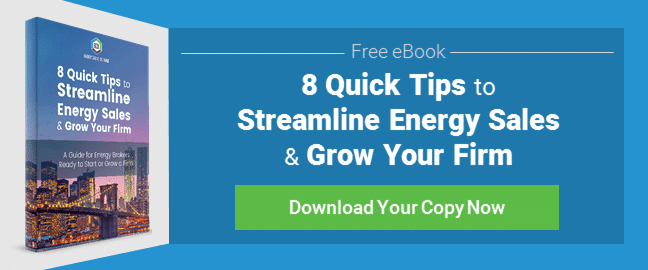As a broker with BOX, you have access to a lot of resources. So it’s important to understand the different energy deal components you’ll be working with.
Of course, the first and most important step any broker can take is to find a new customer. This is often someone whose contract is coming to an end and is ready to re-evaluate their energy service.
But once you’ve found that person, where do you go from there? Let’s look at the process of closing deals and how BOX makes it easier.
Deal Components
When you find a lead, the first step is to ask for a complete bill copy. It needs to have been issued within the last three months and there shouldn’t be any forward balance. Suppliers use this for usage estimates, credit purposes, rate class, and demand calculations.
You’ll want to take note of the load factor because some suppliers have limitations on the load factors they will accept. For example, a supplier might not accept any deals that have a load factor that is less than 35 percent.
Once you have your bill copy, you’ll need to get your pricing from BOX. From there, you’ll see everything that is available and save the supplier prices that you want to bring to the customer. This shows the customer you have access to the necessary resources to help them.
Once the customer is ready to move forward with a contract, you will use the BOX portal to set it up. When the contract is generated, you’ll want to get the contract signed so you can submit it for approval.
Matrix vs. Custom Pricing
Matrix pricing is daily pricing you have access to from suppliers. It varies based on factors like the state, utility, rate class, annual usage, demand, and more.
Matrix pricing is used for deals that are under a certain threshold. For gas, that threshold would be less than 50,000 Therms annually. For electricity, it would be under one million kilowatt hours annually.
Custom pricing is for deals that go over that threshold. However, the process for how you will initiate those two types of pricing are very different.
In the portal, you have immediate access to daily matrix pricing. Custom pricing takes much longer because it requires quite a bit of customization on the supplier’s end. It usually takes three to five business days to get custom pricing processed so it requires more planning on your end.
Custom pricing also requires more documentation than matrix pricing. In addition to the bill copy, you’ll need a signed letter of authorization (LOA). This allows you to pull usage from the utility on the customer’s behalf.
You’ll also need a signed letter of exclusivity (LOE). This is very important because the supplier is putting a lot of time and resources into creating these custom deals. The LOE allows them to feel confident the deal is likely to close.
How Does BOX Help Energy Brokers?
So now that you understand the different components that go into closing a deal, let’s look at how BOX helps you through this process.
What does BOX do? First, we are your source for getting licensed. Depending on the market you’re in, a lot goes into the process of getting licensed as an energy broker. But when you partner with BOX, you operate under our license and have access to all deregulated markets.
We also give you access to supplier pricing so you can offer the best rates to your customers. Our network includes over 75 of the top suppliers throughout the U.S.
BOX also give you great back office support which includes a business manager, pricing team, and commissions team. And our EnergyEngine provides an expedited process for generating contracts.
And most importantly, we maximize your potential earnings. We give you the support you need so you can close deals faster, maximize your deal flow, and increase your income potential.
Sound interesting? Learn more about joining the BOX network of energy brokers.




